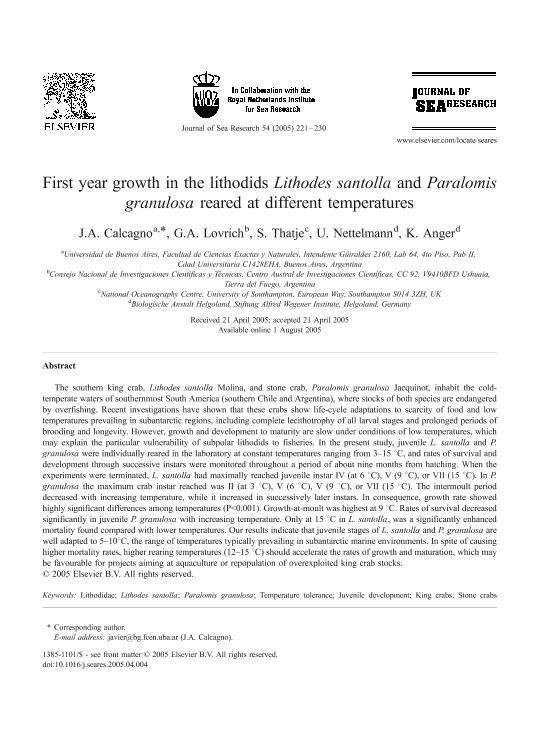Mostrar el registro sencillo del ítem
dc.contributor.author
Calcagno, Javier Ángel

dc.contributor.author
Lovrich, Gustavo Alejandro

dc.contributor.author
Thatje, S.
dc.contributor.author
Nettelmann, U.
dc.contributor.author
Anger, K.
dc.date.available
2022-04-27T14:30:28Z
dc.date.issued
2005-10
dc.identifier.citation
Calcagno, Javier Ángel; Lovrich, Gustavo Alejandro; Thatje, S.; Nettelmann, U.; Anger, K.; First year growth in the lithodids Lithodes santolla and Paralomis granulosa reared at different temperatures; Elsevier Science; Journal of Sea Research; 54; 3; 10-2005; 221-230
dc.identifier.issn
1385-1101
dc.identifier.uri
http://hdl.handle.net/11336/155870
dc.description.abstract
The southern king crab, Lithodes santolla Molina, and stone crab, Paralomis granulosa Jacquinot, inhabit the coldtemperatewaters of southernmost South America (southern Chile and Argentina), where stocks of both species are endangeredby overfishing. Recent investigations have shown that these crabs show life-cycle adaptations to scarcity of food and lowtemperatures prevailing in subantarctic regions, including complete lecithotrophy of all larval stages and prolonged periods ofbrooding and longevity. However, growth and development to maturity are slow under conditions of low temperatures, whichmay explain the particular vulnerability of subpolar lithodids to fisheries. In the present study, juvenile L. santolla and P.granulosa were individually reared in the laboratory at constant temperatures ranging from 3–15 8C, and rates of survival anddevelopment through successive instars were monitored throughout a period of about nine months from hatching. When theexperiments were terminated, L. santolla had maximally reached juvenile instar IV (at 6 8C), V (9 8C), or VII (15 8C). In P.granulosa the maximum crab instar reached was II (at 3 8C), V (6 8C), V (9 8C), or VII (15 8C). The intermoult perioddecreased with increasing temperature, while it increased in successively later instars. In consequence, growth rate showedhighly significant differences among temperatures (Pb0.001). Growth-at-moult was highest at 9 8C. Rates of survival decreasedsignificantly in juvenile P. granulosa with increasing temperature. Only at 15 8C in L. santolla, was a significantly enhancedmortality found compared with lower temperatures. Our results indicate that juvenile stages of L. santolla and P. granulosa arewell adapted to 5–108C, the range of temperatures typically prevailing in subantarctic marine environments. In spite of causinghigher mortality rates, higher rearing temperatures (12–15 8C) should accelerate the rates of growth and maturation, which maybe favourable for projects aiming at aquaculture or repopulation of overexploited king crab stocks.
dc.format
application/pdf
dc.language.iso
eng
dc.publisher
Elsevier Science

dc.rights
info:eu-repo/semantics/openAccess
dc.rights.uri
https://creativecommons.org/licenses/by-nc-sa/2.5/ar/
dc.subject
JUVENILE DEVELOPMENT
dc.subject
KING CRABS
dc.subject
LITHODES SANTOLLA
dc.subject
LITHODIDAE
dc.subject
PARALOMIS GRANULOSA
dc.subject
STONE CRABS
dc.subject
TEMPERATURE TOLERANCE
dc.subject.classification
Ecología

dc.subject.classification
Ciencias Biológicas

dc.subject.classification
CIENCIAS NATURALES Y EXACTAS

dc.title
First year growth in the lithodids Lithodes santolla and Paralomis granulosa reared at different temperatures
dc.type
info:eu-repo/semantics/article
dc.type
info:ar-repo/semantics/artículo
dc.type
info:eu-repo/semantics/publishedVersion
dc.date.updated
2022-04-26T18:13:11Z
dc.journal.volume
54
dc.journal.number
3
dc.journal.pagination
221-230
dc.journal.pais
Países Bajos

dc.journal.ciudad
Amsterdam
dc.description.fil
Fil: Calcagno, Javier Ángel. Universidad de Buenos Aires. Facultad de Ciencias Exactas y Naturales; Argentina. Consejo Nacional de Investigaciones Científicas y Técnicas; Argentina
dc.description.fil
Fil: Lovrich, Gustavo Alejandro. Consejo Nacional de Investigaciones Científicas y Técnicas. Centro Austral de Investigaciones Científicas; Argentina
dc.description.fil
Fil: Thatje, S.. University of Southampton; Reino Unido
dc.description.fil
Fil: Nettelmann, U.. Stiftung Alfred Wegener Institute; Alemania
dc.description.fil
Fil: Anger, K.. Stiftung Alfred Wegener Institute; Alemania
dc.journal.title
Journal of Sea Research

dc.relation.alternativeid
info:eu-repo/semantics/altIdentifier/doi/http://dx.doi.org/10.1016/j.seares.2005.04.004
dc.relation.alternativeid
info:eu-repo/semantics/altIdentifier/url/https://www.sciencedirect.com/science/article/abs/pii/S138511010500033X
Archivos asociados
